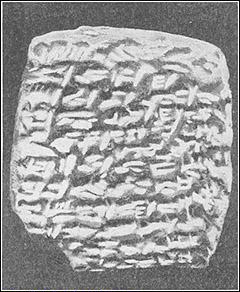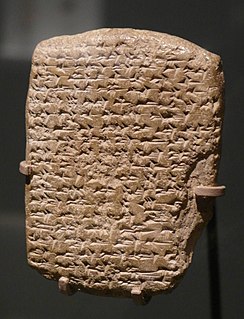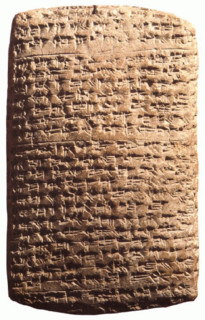
Amarna letter EA 282 is a relatively short ovate clay tablet Amarna letter, located in the British Museum, no. 29851.

Amarna letter EA 252, titled: Sparing One's Enemies, is a square, mostly flat clay tablet letter written on both sides, and the bottom edge. Each text line was written with a horizontal line scribed below the text line, as well as a vertical left margin-line, scribe line on the obverse of the tablet. The letter contains 14 (15) lines on the obverse, continuing on the bottom tablet edge to conclude at line 31 on the reverse, leaving a small space before the final tablet edge. At least 4 lines from the obverse intrude into the text of the reverse, actually dividing the reverse into a top half and bottom half, and even creating a natural spacing segue to the reverse's text, and the story.

Amarna letter EA 365, titled Furnishing Corvée Workers, is a squarish, mostly flat clay tablet, but thick enough (pillow-shaped), to contain text that continues toward the right margin, the right side of the obverse side, and also to the right side of the reverse side of the tablet.

Amarna letter EA 364, titled Justified War, is a clay tablet letter from Ayyab, ruler of Aštartu, to Pharaoh Akhenaten.

Amarna letter EA 86, titled: Complaint to an Official, is a somewhat moderate length clay tablet letter from Rib-Hadda of city-state Byblos to Amanappa, an official at the court of the Pharaoh.

Amarna letter EA 367, titled From the Pharaoh to a Vassal, is a medium-small, square clay tablet Amarna letter to Endaruta of Achshaph,, one of only about 10 letters of the el-Amarna corpus, that is from the Pharaoh of Egypt to his correspondent.

Amarna letter EA 271, titled: "The Power of the 'Apiru," is a moderately short, tallish, rectangular clay tablet letter, approximately 3 in wide x 4 in tall, from Milkilu the mayor/ruler of Gazru (Gezer), of the mid 14th century BC Amarna letters.

Amarna letter EA 270, titled: "Extortion," is an ovate-shaped, medium-sized, tall letter, approximately 3 in wide x 4 in tall, from Milkilu the mayor/ruler of Gazru (Gezer), of the mid 14th century BC Amarna letters.

Amarna letter EA 287, titled: "A Very Serious Crime," is a tall, finely-inscribed clay tablet letter, approximately 8 in tall, from Abdi-Heba the mayor/ruler of Jerusalem, of the mid 14th century BC Amarna letters. The scribe of his six letters to Egypt were penned by the "Jerusalem scribe"; EA 287 is a moderately long, and involved letter. The Amarna letters, about 300, numbered up to EA 382, are a mid 14th century BC, about 1350 BC and 20–25 years later, correspondence. The initial corpus of letters were found at Akhenaten's city Akhetaten, in the floor of the Bureau of Correspondence of Pharaoh; others were later found, adding to the body of letters.

Amarna letter EA 362, titled: "A Commissioner Murdered," is a finely-inscribed clay tablet letter from Rib-Haddi, the mayor/'man' of the city of Byblos,. Byblos, being a large coastal seaport Mediterranean city, was a city that was aligned with Egypt (Miṣri), and housed an Egyptian community. Rib-Haddi, as the city-state leader wrote the largest number of letters to the Pharaoh, in a sub-corpus of the 1350 BC Amarna letters.

Amarna letter EA 245, titled: "Assignment of Guilt," is a medium length clay tablet Amarna letter from Biridiya the governor-'mayor' of Magidda. It is letter number four of five from Biridiya.

Amarna letter EA 325, titled: "Preparations Completed (2)," is a shorter-length clay tablet Amarna letter from Yidya the governor-'mayor' of Ašqaluna-(Ashkelon). It is a letter addressing the Pharaoh in high terms, as well as stating the 'governor of Ašqaluna' is making preparations for the arrival of the Pharaoh's archer-army, the archers. EA 325 is a vassal-state letter, and has some similar appearances, for example appearing like letters EA 270 and EA 271.

Amarna letter EA 15, titled Assyria Joins the International Scene, is a shorter-length clay tablet Amarna letter from Ashur-uballit I of the Land of Assyria,. He addresses the Pharaoh in line 1, the "King (of) Land Miṣri-(Egypt)", thus the use of "Land (of) Assyria".

Amarna letter EA 26, titled To the Queen Mother: Some Missing Gold Statues, is a shorter-length clay tablet Amarna letter from Tushratta of Mittani. Unlike the next letter EA 27 from Tushratta, which is more than twice as tall, and about twice as wide-(XXVII paragraphs), EA 26 is topical and synoptic about recent events about the desire for 'gold statues'. The letter is addressed to the Pharaoh's wife, Teye, and its dimensions are approximately: 6.0 inches (15 cm) tall, 3.5 inches (9 cm) wide, and 1.0 inch (3 cm) thick.

Amarna letter EA 100, titled: "The City of Irqata to the King" is a short-, to moderate-length clay tablet Amarna letter from the city-state of Irqata,, written to the Pharaoh of Egypt. Only one other city sent a clay tablet Amarna letter to the Pharaoh, namely Tunip, letter EA 59, titled: "From the Citizens of Tunip".

Amarna letter EA 256, in short EA 256, catalogued under the title Oaths and Denials, is one of a total of about 350 so-called Amarna letters, belonging to an official correspondence dating to the mid-14th century BC. The initial corpus of letters were found at Akhenaten's city Akhetaten, on the floor of the Bureau of Correspondence of Pharaoh; others were later found, adding to the body of letters.

Amarna letter EA 34, titled: "The Pharaoh's Reproach Answered", is a moderately tall clay tablet Amarna letter from the King of Alashiya.

Amarna letter EA 299, titled: "A Plea for Help", is a fairly short clay tablet Amarna letter from "governor" Yapahu of city-state Gazru. The clay tablet surface has been partially eroded, but the cuneiform is still mostly legible.

Amarna letter EA 75, titled: "Political Chaos", is a short to moderate length letter from Rib-Hadda, who wrote the largest number of Amarna letters in a sub-corpus, from the city-state of Byblos; Byblos contained an Ancient Egyptian colony, and was aligned with a few neighboring townsites.

Amarna letter EA 147, titled A Hymn to the Pharaoh, is a moderate length clay tablet Amarna letter from Abimilku of Tyre-(called Ṣurru in the Abimilku letters, and an island, until the time of Alexander the Great, 330 BC). The letter is a twin letter to EA 149, which is identical in length, and complexity, and EA 147 appears to precede EA 149.



















